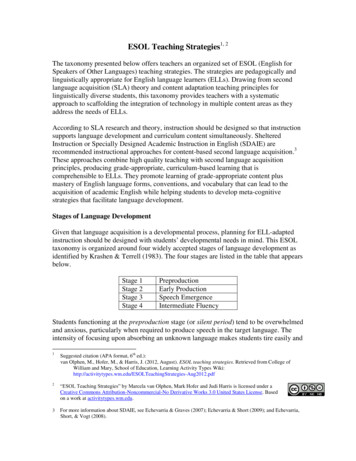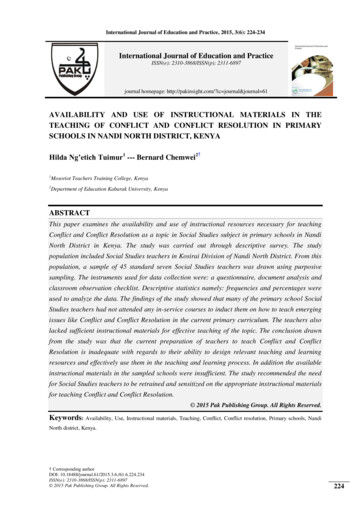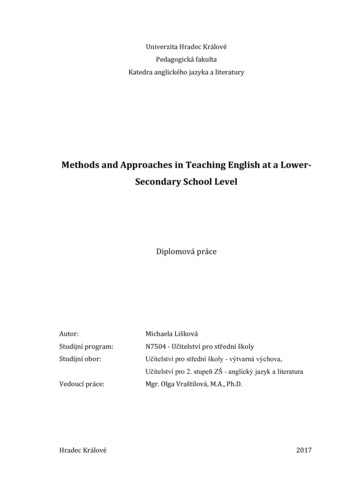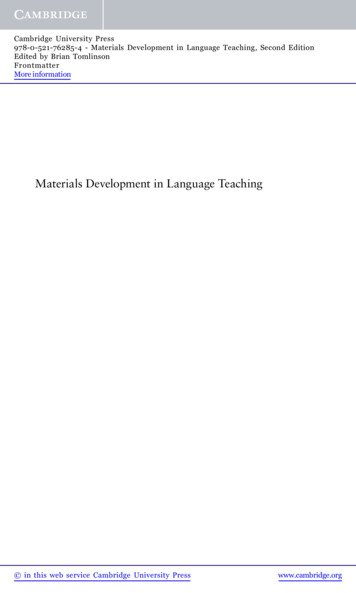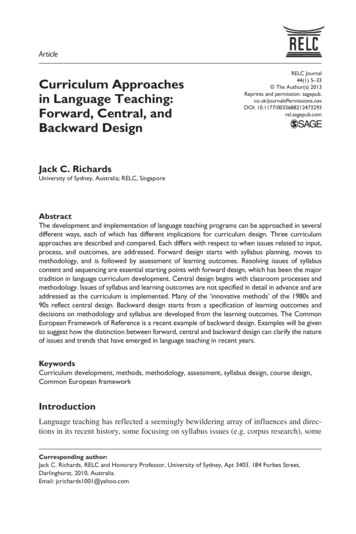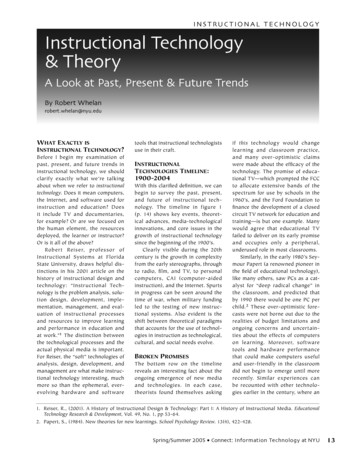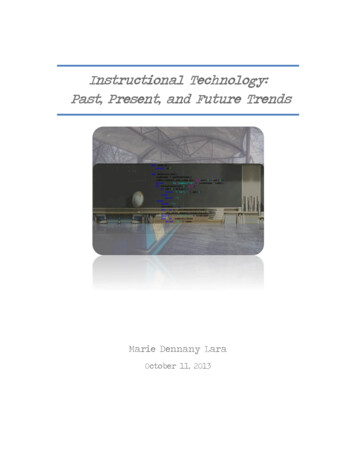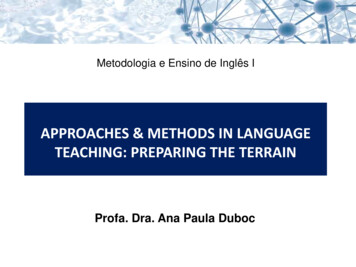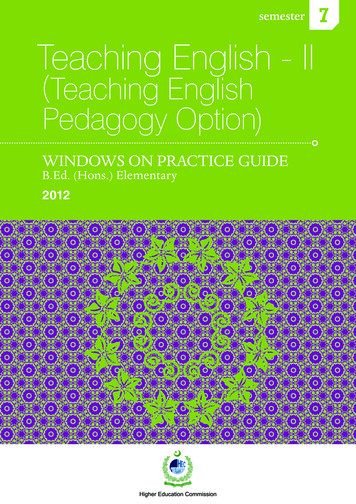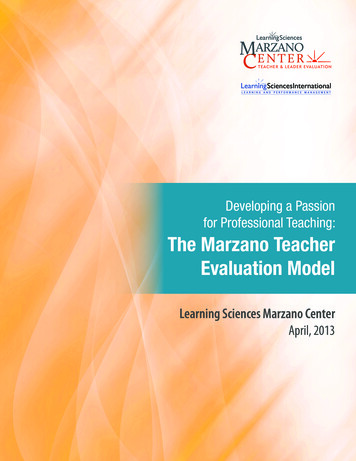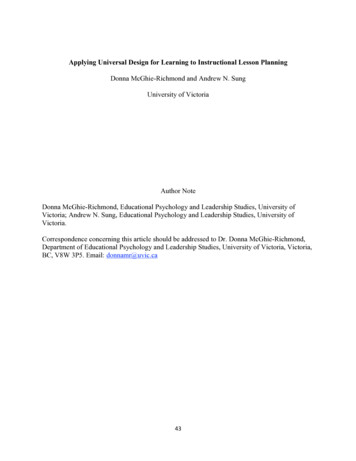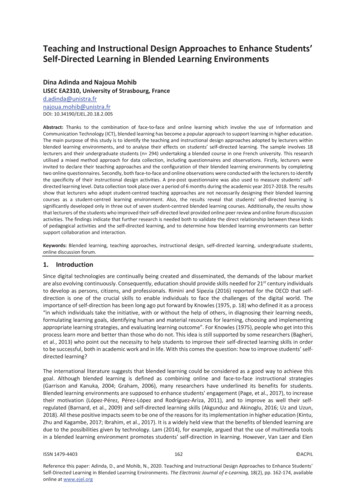
Transcription
Teaching and Instructional Design Approaches to Enhance Students’Self-Directed Learning in Blended Learning EnvironmentsDina Adinda and Najoua MohibLISEC EA2310, University of Strasbourg, I: 10.34190/EJEL.20.18.2.005Abstract: Thanks to the combination of face-to-face and online learning which involve the use of Information andCommunication Technology (ICT), blended learning has become a popular approach to support learning in higher education.The main purpose of this study is to identify the teaching and instructional design approaches adopted by lecturers withinblended learning environments, and to analyse their effects on students’ self-directed learning. The sample involves 18lecturers and their undergraduate students (n 294) undertaking a blended course in one French university. This researchutilised a mixed method approach for data collection, including questionnaires and observations. Firstly, lecturers wereinvited to declare their teaching approaches and the configuration of their blended learning environments by completingtwo online questionnaires. Secondly, both face-to-face and online observations were conducted with the lecturers to identifythe specificity of their instructional design activities. A pre-post questionnaire was also used to measure students’ selfdirected learning level. Data collection took place over a period of 6 months during the academic year 2017-2018. The resultsshow that lecturers who adopt student-centred teaching approaches are not necessarily designing their blended learningcourses as a student-centred learning environment. Also, the results reveal that students' self-directed learning issignificantly developed only in three out of seven student-centred blended learning courses. Additionally, the results showthat lecturers of the students who improved their self-directed level provided online peer review and online forum discussionactivities. The findings indicate that further research is needed both to validate the direct relationship between these kindsof pedagogical activities and the self-directed learning, and to determine how blended learning environments can bettersupport collaboration and interaction.Keywords: Blended learning, teaching approaches, instructional design, self-directed learning, undergraduate students,online discussion forum.1.IntroductionSince digital technologies are continually being created and disseminated, the demands of the labour marketare also evolving continuously. Consequently, education should provide skills needed for 21st century individualsto develop as persons, citizens, and professionals. Rimini and Sipezia (2016) reported for the OECD that selfdirection is one of the crucial skills to enable individuals to face the challenges of the digital world. Theimportance of self-direction has been long ago put forward by Knowles (1975, p. 18) who defined it as a process“in which individuals take the initiative, with or without the help of others, in diagnosing their learning needs,formulating learning goals, identifying human and material resources for learning, choosing and implementingappropriate learning strategies, and evaluating learning outcome”. For Knowles (1975), people who get into thisprocess learn more and better than those who do not. This idea is still supported by some researchers (Bagheri,et al., 2013) who point out the necessity to help students to improve their self-directed learning skills in orderto be successful, both in academic work and in life. With this comes the question: how to improve students’ selfdirected learning?The international literature suggests that blended learning could be considered as a good way to achieve thisgoal. Although blended learning is defined as combining online and face-to-face instructional strategies(Garrison and Kanuka, 2004; Graham, 2006), many researchers have underlined its benefits for students.Blended learning environments are supposed to enhance students' engagement (Page, et al., 2017), to increasetheir motivation (López-Pérez, Pérez-López and Rodríguez-Ariza, 2011), and to improve as well their selfregulated (Barnard, et al., 2009) and self-directed learning skills (Akgunduz and Akinoglu, 2016; Uz and Uzun,2018). All these positive impacts seem to be one of the reasons for its implementation in higher education (Kintu,Zhu and Kagambe, 2017; Ibrahim, et al., 2017). It is a widely held view that the benefits of blended learning aredue to the possibilities given by technology. Lam (2014), for example, argued that the use of multimedia toolsin a blended learning environment promotes students’ self-direction in learning. However, Van Laer and ElenISSN 1479-4403162 ACPILReference this paper: Adinda, D., and Mohib, N., 2020. Teaching and Instructional Design Approaches to Enhance Students’Self-Directed Learning in Blended Learning Environments. The Electronic Journal of e-Learning, 18(2), pp. 162-174, availableonline at www.ejel.org
Dina Adinda and Najoua Mohib(2016) and Ibrahim, et al. (2017) found that researches on blended learning mostly examine the impact oftechnology, leaving aside the pedagogical aspect.The purpose of this study is to explore more fully this issue by analysing the effects of teaching and instructionaldesign approaches on students' self-directed learning in a blended learning context. While a number ofresearchers highlight the advantages of blended learning, Poon (2003) states that the quality of learningachievement depends, to a large extent, both on the teachers’ conception of teaching and learning and the typeof teaching-learning environment provided. The key research question in this paper is: “what are the effectiveteaching and instructional design approaches that enhance students’ self-directed learning within a blendedlearning environment?” The next section presents the literature review followed by the methodology(participants and research design) and the findings. The paper ends with a discussion and a conclusion.2.Literature review2.1 Blended learning instructional approachBlended learning can be defined as an instructional teaching approach that combines online and face-to-faceteaching and learning sessions (Boelens, et al., 2015). This definition is generally shared by other researchers(Horn and Staker, 2015) although various definitions depending on the context exist (Graham, 2006). ForGarrison and Kanuka (2004), the effective combination of the two instructional methods is the main challenge.Some researchers (Peraya, et al., 2012; Horn and Stakers, 2015) highlight the importance of articulating onlineand face-to-face teaching to enable students to control their activities. While Graham (2013, p.23) claims thattheorical frameworks are helpful to “guide practice”, Lebrun, et al. (2014, pp.64-71) suggest a typology of 6configurations of blended learning environments: “scene”, “screen”, “cockpit”, “crew”, “metro” and“ecosystem”. All these configurations have been classified into two instructional design approaches: teachercentred and student-centred learning. Table 1 gives a description of each configuration.Table 1: A typology of blended learning environment (Peraya and Peltier, 2012; Peraya, Charlier andDeschryver 2014)Instructional designapproachConfigurationDescription1. SceneContent-oriented configuration. The online environment is composedprincipally of textual resources, which are used to support the face-toface course.Content-oriented configuration. The online environment is used tosupport the face-to-face course. The resources provided online arecomposed of textual and numerous multimedia resources.The online management tools are used to allow students to managetheir learning. Several reflexive activities are also provided.This model focuses on building knowledge and supportinginterpersonal interaction.This model fosters students' freedom of choice. It provides apossibility for students to access external resources, offers mentoring,and supports interaction among students.Teacher-centred approach(SCA)2. Screen3. Cockpit4. CrewStudent-centred approach(SCA)5. Metro6. EcosystemThis model is characterised by the exploitation of a large number oftechnological and educational possibilities. It provides, for example, apossibility for students to choose their own learning path.This typology has been developed through a European project “HY SUP” (2009-2012) that aimed to both describethe blended learning environments designed in Higher Education (Belgium, France, Luxembourg, Switzerland)and to analyse the impact of blended learning practices on the learning-teaching process. Peraya, Charlier andDeschryver (2014) have identified 5 pedagogical dimensions (see Table 2) for each blended learningenvironment as follows : “combination” which refers to inter-mixing online and face-to-face strategies (1),“mediatisation” defined in terms of e-learning and instructional design (2), “mediation” related to the effects ofmedia on behaviours (3), “teacher and student mentoring” including cognitive, metacognitive and motivationalcomponents (4), and “degree of openness” or “flexibility” that makes it possible for students to select the wayof learning and the resources they need and to interact with the external actors (5).www.ejel.org163ISSN 1479-4403
The Electronic Journal of e-Learning Volume 18 Issue 2 2020Table 2: Pedagogical dimensions and components of blended learning environments (Peraya and Peltier, 2012;Lebrun et al., 2014)DimensionsConstitutive components1. CombinationStudents’ participation in face-to-face sessions2. MediatisationProvision of learning toolsStudents' participation in the online platformProvision of management, communication, and interaction toolsResources in multimedia formatWorks in multimedia formSynchronous communication and collaboration tools usedPossibility provided to students to comment and annotate documents3. MediationReflexive and relational objectives4. Teacher and studentmentoringMethodological supports provided by the teacherMetacognitive supports provided by the teacherPeer-support5. Degree of openness orflexibilityFreedom of choice of learning methodsUse of resources and external actorsThe six “HY SUP” typology is very popular in the French-speaking research area and gave rise to severalpublications (see project website HY-SUP) revealing that student-centred approaches have positive effects onstudents’ engagement and motivation in the blended learning context. However, Peraya, Charlier andDeschryver (2014) recognize that further researches need to be conducted to know more about the impacts ofthe 6 configurations of blended learning environments on the learning process. For example, no evidence hasbeen given yet to declare with Jézégou (2014) that student-centred blended learning approach (“crew”, “metro”,“ecosystem” configurations) encourage students to take control of their own learning. If this typology is veryinteresting to keep, it is focused only on the instructional design approach. Therefore, it is also important to takeinto account the teaching approaches regarding their potential effects on students’ learning outcomes (Gerbic,2011).2.2 Teaching approachesFor Kember (1997) and many others (Trigwell, Prosser and Taylor, 1994; Trigwell, Prosser and Waterhouse, 1999;Prosser, et al., 2005), teaching approaches are related to conceptions of teaching, which are influenced by theirbeliefs about teaching and their perception of their teaching environment. These approaches can bedistinguished in two ways: “teacher-centred/content” and “student-centred/learning” (Kember, 1997). All thesecategories are summarised below in the Table 3.Trigwell, Prosser and Waterhouse (1999) established a relationship between teachers’ approaches to teachingand students’ approaches to learning. For these authors, teacher-centred approach is related to a surfaceapproach, whereas student-centred approach is associated with a deep approach to learning. Similarly, Kember,Leung and Mcnaught (2008) observe that teachers’ approaches focused on transmitting knowledge andinformation are more likely to promote surface learning approaches, whereas teachers’ approaches focused onsupporting a greater level of students' interaction and discussion tend to promote deep learning approaches.On the one hand, when the teachers focus on their teaching, they pay more attention to knowledge transferand students’ notes. On the other hand, when they focus on students, they provide opportunities for activelearning in which students are actively involved in their learning, not only to listen and receive knowledgetransferred, but also to engage in “higher-order thinking tasks” like discussion, solving problems, analysis,synthesis, evaluation (Bonwell and Eison, 1991, p.5), and to think about their own actions or activities (Prince,2004). According to Kane (2004), active learning also supports critical thinking, fosters autonomy, and ensuresthat students become the actor of their learning. In fact, many studies establish a close link between studentcentred teaching approaches and self-directed learning (Plush and Kehrwald, 2014; Horn and Staker, 2015).www.ejel.org164 ACPIL
Dina Adinda and Najoua MohibTable 3: A model of teachers’ approaches (adapted from Kember, 1997; Kember and Kwan, 2000)Teachers’ approachesContent-centred or Teachercentred approach (TCA)Content-centred or Teachercentred approach (TCA)Learning-centred orStudent-centred approach(SCA)Conceptions of teachingTeaching activitiesImparting informationTeachers' objective is to transfer all the information thatstudents need. Examples of activity: lecture-basedteaching or "chalk and talk."Teachers’ objective is to transfer the information and tohelp students to understand it (students are informed ofthe lesson plan; teachers use examples and analogies).Examples of activity: lecture-based teaching with astructured guide.Transmitting structuredknowledgeFacilitating understandingTeachers’ objective is to help students to learn bythemselves and to "become more effective as a teacher."Examples of activity: debate, tutorial, project-basedlearning, working in small chers’ objective is to promote the evolution ofstudents’ understanding and perspective of the subjectmatter. Their aim is to become "more effective infacilitating students' learning." Examples of activity:debate, reflexive discussions, problem-based learning.2.3 Self-directed learningThe term of “self-directed learning” is grounded in two concepts: self-determination and self-regulation (Carré,2003). In this perspective, learning involves motivation, control, and goal setting. The self-determination(hereafter SDT) is a core concept widely used in educational research to explain learner motivation defined as aprocess in which an individual seeks to satisfy one of his/her three fundamental human innate needs:competence, relatedness, and autonomy (Deci and Ryan, 2000a). Self-directed learning (hereafter SDL) and selfregulated learning (hereafter SRL) are usually used as synonyms (Loyens, Magda and Rikers, 2008; Saks andLeijen, 2014). Cosnefroy and Carré (2014, pp.2-3) argue that both concepts are “close neighbours” and may becomplementary in terms of their characteristics (learners, approaches, and scope). Although similarities aremore emphasised than differences (Loyens, Magda and Rikers, 2008), there are some specific definitions duemainly to the various theoretical frameworks (Noël and Cartier, 2016). From the social cognitive perspective,self-regulation "refers to self-generated thoughts, feelings, and actions that are planned and cyclically adaptedto the attainment of personal goals" (Zimmerman, 2005, p. 14). As a result, self-regulated students use processessuch as goal setting, self-evaluation and learning strategies, that can be taught (Zimmerman, 2002). Similarly,Cosnefroy and Carré (2014) explain that SDL can be described as a process in which learners are able to diagnosetheir learning needs, formulate their learning goals, identify their resources for learning, choose and implementtheir learning strategies, and evaluate learning outcomes. As stated by Loyens, Magda and Rikers (2008),followed by Cosnefroy and Carré (2014), SDL both requires SRL and implies more student control, especially atthe beginning of the learning process. To sum up, to become a self-directed learner, students need to practiceself-regulation as well as self-determination (Deci and Ryan, 2000b).The SDL concept has attracted widespread interest both in the research domain and as professional practices(teachers, adult educators, policy-makers, ) over the past few years. SDL is currently considered as playing acrucial role in learning processes especially in deep-level processing (Candy, 1991). The existing researches onSDL have demonstrated correlations with performance outcomes and academic achievement, especially inonline environments (Dabbagh, 2007; Lounsbury, et al., 2009; López-Pérez, Pérez-López and Rodríguez-Ariza,2011). It is argued that open and distance environments are designed to foster self-direction by giving a studentthe freedom to choose how and what to learn as well as encouraging social interactions between learners (Carré,et al., 2011). Recent research suggests also that blended learning environments help students to develop theirself-directed learning skills (Sriarunrasme, Techataweewan and Mebusaya, 2015; Uz and Uzun, 2018). However,there are few studies of lecturers’ approaches to teaching in blended learning context and their relationshipwith approaches of instructional design.2.4 Research objectives and hypothesisA number of authors (Loyens, Magda and Rikers, 2008; Van den Akker, et al., 2013) point out that the teachers’role is to support students to become self-directed learners. As mentioned earlier, two approaches, “theteacher-centred” and “the student-centred” ones, can be identified both for teaching (Trigwell, Prosser andwww.ejel.org165ISSN 1479-4403
The Electronic Journal of e-Learning Volume 18 Issue 2 2020Taylor, 1994) and blended learning instructional design (Peraya and Peltier, 2012). This study seeks to examinewhich teaching and instructional design approaches may help students to increase their self-directed learningskills in a blended learning context. Hence, it could conceivably be hypothesised that: firstly, lecturers who adoptstudent-centred teaching approaches are more likely to design their blended learning courses as a studentcentred learning environment; and secondly, student-centred teaching approaches associated with blendedstudent-centred approaches enhance students’ self-directed learning.3.Methodology3.1 ParticipantsThe sample consisted of 18 lecturers and 294 undergraduate students enrolled in a blended learning courseoffered by a French university during the 2017-2018 academic year. A total of eight academic disciplines wererepresented: sociology, foreign languages, mathematics, economics, law, physics, educational sciences, andcommunication. All participants (lecturers and students) were briefed on the main aim of the study and signedinformed consent forms in accordance with the guidelines of the university’s Research Ethics Committee. Theparticipants were assured that their response would remain confidential and anonymous. They were also freeto withdraw from the study at any stage.3.2 Research methodsThis study used a mixed methods design that combines both quantitative and qualitative approaches. The goalof the mixed methods approach was to gain a deep understanding of the impact of the pedagogical approachesused in blended learning on students’ self-directed learning. Qualitative and quantitative data were collected,through questionnaires, to identify the lecturers’ teaching and instructional design approaches that impactpositively the students’ self-directed learning in a blended learning context. Both offline and online classroomobservations were also conducted in order to examine the instructional activities offered in the student-centredblended learning environments. The data collection and procedures are described in more details in thefollowing section.3.3 Data collection3.3.1Data Collection from LecturersDifferent instruments (questionnaires and observations) have been used with all the lecturers (n 18). Lecturerswere asked, just before their first course, to fill out an online questionnaire: The Approach to Teaching Inventory(ATI) (Trigwell, Prosser and Ginns, 2005). This questionnaire (ATI) seemed to be relevant for this study casebecause it was developed in order “to explore the relations between a teacher’s approaches to teaching and theapproaches to learning of students in the classes of those teachers” (Trigwell and Prosser, 2004, p.416). Anotherreason which explains the choice of this instrument is that Prosser and Trigwell (2006) consider that teachers’approaches to teaching are contextual and it can differ from one context to another. In other words, teachersmay adopt different approaches in different circumstances (Prosser, et al., 2005). Consequently, it is essentialto identify teachers’ approaches in a specific course to understand the intentions and strategies they adopt fortheir teaching. The original 22-item ATI consisted of 11 items on “conceptual change/student-centred teachingapproaches” scale and 11 items on “information-transmission/teacher-centred teaching approach” scale. Eachof them, constructed by two subscales (“teaching intention” and “strategy”), was rated on a 5-point Likert scale(from 1: only rarely to 5: almost always). Although ATI is a popular instrument, only a Canadian French translationhas been found for the original 16-item ATI (Trigwell and Prosser, 2004). For this work, the original 22-item ATIwas translated into French by native speakers with expertise in education. The overall reliability generated forthis French version of ATI was 0.815 Cronbach s alpha. However, the Pearson test conducted to determine thevalidity of the instrument showed that the correlation of each item to their respective scales was generallystrong except for item 2 (r 0,180). The removal of this item didn’t affect the validity of the instrument and theoverall Cronbach’s alpha of the 21-item ATI remained good (ɲ 0,747).Immediately after the first questionnaire was collected, the lecturers completed a second online questionnaire:the Self-Positioning Tool (SPT) (Deschryver and Charlier, 2012). The SPT has been developed in the HY-SUPEuropean research project to identify configurations of the blended-learning environment, which can be usedto analyse the effects on students’ learning and teachers’ professional development. Each lecturer was invitedto examine his blended-learning course using the SPT. This questionnaire consisted of 12 closed questions. 6questions referred to personal data (age, sex, experience, ), the courses (number of students, level of study,www.ejel.org166 ACPIL
Dina Adinda and Najoua Mohibface to face time) and the learning platform. The 6 other questions aimed to measure the 14 blended learningcomponents described above in the literature review, in order to determine which configuration of blendedlearning teachers have implemented. These 6 questions were evaluated on a 4-point scale (frequency orattitude). The SPT is only available in French. The validity of the instrument has already been demonstrated byDeschryver and Charlier (2012).Both online and face-to-face observations were also conducted with the 18 lecturers by the authors over aperiod of one semester. On the one hand, each face-to-face class was observed twice for 50 minutes. The firstobservation was scheduled during the pre-test with the students (see section 3.3.2) whereas the second onetook place one week before the post-test. An observation instrument was developed especially for this studyand showed a good internal consistency (ɲ 0,747). The instrument comprised four dimensions (directivementoring style, supporting mentoring style, proactive/reactive interventions, context) and 15 items.On the second hand, online observations were carried out near the middle of the semester. All the courses werehosted on Moodle. The following aspects were examined in depth: the tools (wiki, forum, chat, ), the resources(videos, power point slides, articles, ) and the pedagogical activities (discussion, debate, peer assessment, )including the instructions of the lecturers, that were provided for the students to learn. The informationcollected through both face-to-face and online observations aimed to discern the aspects that can supportstudents’ self-directed learning in a student-centred blended learning environment.3.3.2Data Collection from StudentsTo examine the effects of the teaching and instructional design approaches on students’ SDL in a blendedlearning environment, a pre- and post-test were conducted using the Self-Directed Learning Readiness Scale(SDLRS) (Guglielmino, 1977). The SDLRS has been designed to measure the degree to which individuals perceivetheir skills and attitudes necessary for self-directed learning along 8 factors: “self-concept as an effectivelearner”, “openness to learning opportunities”, “initiative and independence to learning”, “acceptance ofresponsibility for one’s own learning”, “love of learning”, “creativity”, “Ability to use basic study andproblem-solving skills” and “positive orientation to the future” (Field, 1989). The instrument is a 58-itemquestionnaire with a 5-point scale Likert type response options, ranging from “almost never true” to “almostalways true”. The questionnaire has been validated in various contexts and translated into many languages. Inthe current study, the French-translated version was used. The study was carried out over a semester periodand a paper questionnaire was given twice to the students, once during the first face-to-face course (i.e. pretest) and again before the last one (i.e. post-test). The Cronbach’s alpha coefficient obtained for the overall itemsof the scale is 0.843, indicating good internal consistency of reliability.4FindingsThe data gathered from the lecturers through both the questionnaires (ATI and SPT) and the observations (faceto-face and online courses) have been analysed qualitatively whereas the students’ responses were examinedby a paired sample t-test.4.3 Teaching and blended learning instructional approachesLecturers' responses (n 18) to ATI and SPT questionnaires have been gathered in one table; Table 4 shows thatlecturers' approaches to teaching and to design blended learning may be divergent or convergent. By taking intoaccount the teachers’ teaching approaches and the blended learning instructional approaches, 4 combinationsemerged: the student-centred (7 lecturers; B, C, D, F, K, L, P), the teacher-centred (4 lecturers; E, G, H, J), thestudent/teacher-centred (4 lecturers; A, I, M, N) and the teacher/student-centred (3 lecturers; O, Q, R). Theseresults demonstrate that lecturers who adopt a student-centred teaching approach are not necessarily designingtheir blended learning courses as a student-centred learning environment. Among the 11 lecturers who use astudent-centred teaching approach, 4 of them adopt a teacher-centred blended learning approach while 7 ofthem adopt a student-centred blended learning approach. Accordingly, the first hypothesis is not fullyconfirmed.www.ejel.org167ISSN 1479-4403
The Electronic Journal of e-Learning Volume 18 Issue 2 2020Table 4: Results from the Approach to Teaching Inventory (ATI) (Trigwell, Prosser and Ginns, 2005) and theSelf-Positioning Tool (SPT) (Deschryver and Charlier, 2012)Lecturers IDATeachers’teaching approachStudent-centredBlended learningconfigurationSceneBlended learning -centredIn addition, the 6 configurations of blended learning environments, as described above by Peraya, et al. (2012)have been mentioned by the lecturers. Table 5 below indicates that the most represented configuration is“Metro”, which referred to a student-centred blended learning instructional approach. As well as to supportstudents’ active participation in online and face-to-face session, Deschryver and Charlier (2012) state that thisconfiguration of blended learning environment aims to provide students' freedom of choice by giving them thepossibility to access external resources, offering human mentoring and supporting active interactions throughpeer reviews, peer-mentoring or mentoring from tutor/lecturer. The supports provided can be managed in theonline platform or in face-to-face sessions through various actions (online forum discussion, wiki, group project,online or offline individual peer review, etc.).Table 5: Frequencies of blended learning instructional approaches from the lecturers’ responses to the SelfPositioning Tool (SPT) (Deschryver and Charlier, 2012)Blended learning instructionalapproachTeaching-centred(A, E, G, H, I, J, M, N)Student-centred(B, C, D, F, K, L, O, P, Q, ewMetroEcosystemFrequency(N 18)Percentage per type332181N 1817%17%12%5%44%5%100 %Percentage perapproach46%54%In order to examine the second hypothesis that student-centred teaching and blended learning instructionalapproaches would enh
of pedagogical activities and the self-directed learning, and to determine how blended learning environments can better support collaboration and interaction. Keywords: Blended learning, teaching approaches, instructional design, self-directed learning, undergr
